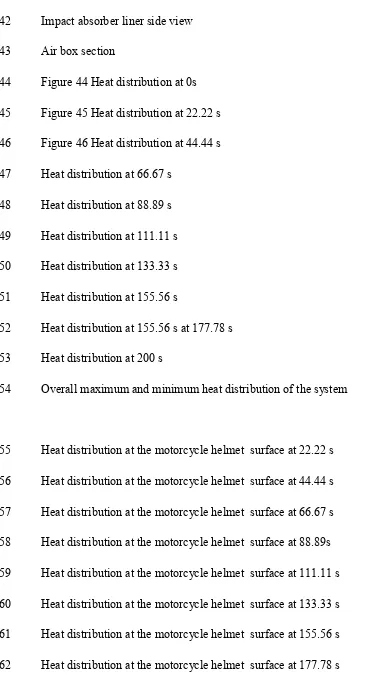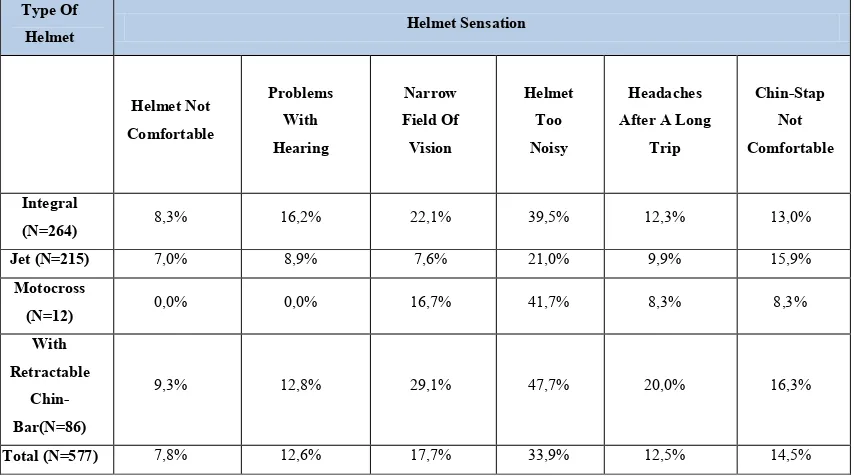i
APPROVAL
This report is submitted to the Faculty of Mechanical Engineering of UTeM as a partial fulfilment of the requirement for the degree of Bachelor of Mechanical Engineering (Design and Innovation) with Honours. The member of the supervisory committee is as follow:
ii
DECLARATION
“I hereby, declare this thesis is result of my own research except as cited in the references”
Signature : ……….. Author`s Name : Rodzman Rozimi Bin Radzi
iii
ACKNOWLEDGEMENT
iv
ABSTRAK
v
ABSTRACT
vi
TABLE OF CONTENT
Approval i
Declaration ii
Acknowledgement iii
Abstract iv
Abstrak v
List of content List of tables List of figures List of Abbreviations
vi ix x xii
CHAPTER I INTRODUCTION
1.1 Background study 1.2 Problem statement 1.3 Project objectives 1.4 Project scope
PAGE 1 2 2 2
CHAPTER II LITERATURE REVIEW
2.1 Introduction
2.2 Motorcycle Helmet layer 2.2.1 Rigid outer shell layer (outer
most layer)
2.2.2 Impact absorbing layer (middle layer)
2.2.3 Comfort/ fit padding layer (inner layer)
2.3 Microclimate heat distribution
vii
2.4 Heat transfer theory
2.4.1 Calculus of finite differences 2.4.2 Numerical analysis
2.4.3 Heat equation 2.4.4 Fluid flow
2.4.5 Multiphase heat transferred
11 11 11 12 13 14
CHAPTER III METHODOLOGY
3.1 Introduction 3.2 Flow chart 3.3 Equipment
3.3.1 Motorcycle helmet and human head 3D model
3.3.2 CATIA V5R16
3.3.3 ANSYS-Fluent Version 12.1.2 3.3.4 Material Properties
15 15 16 17 17 18 18 19
CHAPTER IV PRE-PROCESSING PHASE
4.1 Introduction
4.2 CAD Model Generation 4.3 Meshing Phase
4.4 Transient-Thermal Analysis 4.5 Air flow shape analysis
21 21 22 24 28 32
CHAPTER V RESULT
5.1 Introduction
5.2 Seven Points Analytical Temperature
34 34 34
viii
CHAPTER VII CONCLUSION AND DISCUSSION
7.1 Conclusion 7.2 Recommendation
44 44 45
REFERENCES 46
APPENDIX Appendix A Gantt Chart
Appendix B Human head model Appendix C Transient Thermal Appendix D Air flow analysis
ix
LIST OF TABLES
NO TITLE PAGE
1 Selected subjective parameters as a function of helmet type, expressed as percentage of subjects of both control and accident cases agreeing with the given statements.
5
2 Material Properties 19
3 Heat capacity of human head 19
4 Air convection properties 33
x
LIST OF FIGURES
NO TITLE PAGE
1 Various human head shapes 6
2 Basic motorcycle helmet layers 7
3 Cross section between head and the motorcycle helmet 9
4 Heat trapped between head and motorcycle helmet 10
5 Flow chart 16
6 ANSYS workbench set up 18
7 Assembly view of all parts 22
8 Assembly view for human head and motorcycle helmet 22
9 Isometric view 23
10 Air box, human head, and motorcycle helmet layers model. 23
11 Front view with air box object being hided. 24
12 Human head mesh 25
14 Details view of motorcycle helmet model mesh 25
15 Motorcycle helmet and human head model mesh (medium mesh size)
26
16 Air meshing 26
17 Assembly parts meshing 27
18 Air convection 28
xi
20 Internal heat generation 29
21 Human head temperature 30
22 Heat flux 31
23 Heat flux from surrounding 31
24 Inlet air flow 32
25 Outlet air flow 32
26 Air flow plane and motorcycle helmet 33
27 Temperature probe at point 1 graph 34
28 Temperature probe at point 2 graph 35
29 Temperature probe at point 3 graph 36
30 Temperature probe at point 5 graph 36
31 Temperature probe at point 7 graph 37
32 Graph of Variation in overall maximum and minimum temperature 39
33 Human head model isometric view 49
34 Human head model rear view 50
35 36
Comfort liner
Comfort liner isometric view
50
37 Outermost shell side view 51
38 Outermost shell isometric view 51
39 Outermost shell front view 52
40 Impact absorber liner font view 52
xii
42 Impact absorber liner side view 53
43 Air box section 54
44 Figure 44 Heat distribution at 0s 55
45 Figure 45 Heat distribution at 22.22 s 55
46 Figure 46 Heat distribution at 44.44 s 56
47 Heat distribution at 66.67 s 56
48 Heat distribution at 88.89 s 57
49 Heat distribution at 111.11 s 57
50 Heat distribution at 133.33 s 58
51 Heat distribution at 155.56 s 58
52 Heat distribution at 155.56 s at 177.78 s 59
53 Heat distribution at 200 s 59
54 Overall maximum and minimum heat distribution of the system 60
xiii
63 Heat distribution at the motorcycle helmet surface at 200 s 64 64 Air flow around motorcycle helmet isometric view 65
65 Air flow around motorcycle helmet rear view 65
66 Air flow around motorcycle helmet with heat flux 66
67 Heat flux at human head model 66
68 Air flow around motorcycle helmet with heat flux top view 67 69 Air flow around motorcycle helmet with heat flux 67 70 Air flow around motorcycle helmet cross section view 68
71 Air flow around motorcycle helmet front view 68
72 Air flow around motorcycle helmet side view 69
xiv
LIST OF ABBREVIATIONS
CAD = Computer Aided Engineering
CFD = Computational Fluid Dynamics
A1 = Inlet air flow area
A2 = Exit air flow area
h = Air convection coefficient
PSM = Projek Sarjana Muda
% = Percentage
h = Convective heat coefficient [W/oC]
K = Conductive heat transfer [W]
1
CHAPTER I
INTRODUCTION
1.1 Background Study
All motorcycle helmets consist of three main parts, an impact absorber layer which is made of impact reducing foam, a comfort liner that situated between head and the impact absorber layer and an outer most shell which is made to absorb the initial impact and protect rider`s head as well as take all of the damage that the road or other hard object would have done to the head.[1]
By wearing a helmet is a reflection of your attitude toward riding and shows that they are responsible riders who take motorcycle riding seriously.[2]
2
1.2 Problem Statement
UTeM students mostly are from states out of Melaka. Most of them are using motorcycle. Usually it takes from three to four hours riding from their hometown to Melaka. The long journey may affect their concentration of driving, because of the thermal condition in their helmets. The longer journey they take, the more CO2 and heat released by the riders during their ride.[4] This situation contributes the uncomfortable journey for them, unfortunately this situation may lead to road accident, because of the lack of focus during their riding.
1.3 Project Objectives
The objective of this research is to study the heat distribution inside the motorcycle helmet at different conditions (speeds and ambient temperature) and compare it with experimental result. Besides, the suitable method also will be proposed to improve this heat distribution.
1.4 Project Scope
3
CHAPTER II
LITERATURE REVIEW
2.1 Introduction
We use helmet mostly every day in our life. It is a compulsory if we are on the riding. Motorcycle helmet, according to Longman Dictionary of Contemporary English, 2003, is a strong hard hat that soldiers, motorcycle riders, the police etc. wear to protect their heads. Nowadays, this head protector is used mostly by students, workers and anyone who use motorcycle as their transport
But it is not too comfort for the motorcyclists since there aren’t exist any good ventilation system in the helmet. According to COST 357 Final Report(2005): CO2 and O2 Concentrations in Integral Motorcycle Helmets. Applied Ergonomics, most of road accidents contribute to the critical injuries are factorized by the bad ventilation condition in the helmet. During the riding, the motorcyclist exhaled too much carbon dioxide gas (CO2) and discharge heat from their bodies during respiration process. After about 2 to 3 hours, the concentration of the carbon dioxide gaseous increased in the helmet. The CO2 gaseous is then inhaled by the motorcyclist during their riding. This situation caused them to be less focus on their riding and led to the road accident.
4
scalp trapped between the human head scalp and the helmet (impact absorbing liner) surface. By the way, the finding of his experiment is state that the heat released from the face area is greater than the scalp. So he recommended some improvement for the air to flow around that area.
5
Table 1 Selected subjective parameters as a function of helmet type, expressed as percentage of subjects of both control and accident cases agreeing with the given statements.
Type Of
Helmet Helmet Sensation
Helmet Not Comfortable Problems With Hearing Narrow Field Of Vision Helmet Too Noisy Headaches After A Long
Trip
Chin-Stap Not Comfortable
Integral
(N=264) 8,3% 16,2% 22,1% 39,5% 12,3% 13,0%
Jet (N=215) 7,0% 8,9% 7,6% 21,0% 9,9% 15,9%
Motocross
(N=12) 0,0% 0,0% 16,7% 41,7% 8,3% 8,3%
With Retractable
Chin-Bar(N=86)
9,3% 12,8% 29,1% 47,7% 20,0% 16,3%
Total (N=577) 7,8% 12,6% 17,7% 33,9% 12,5% 14,5%
(source : http://www.cost357.org)
By referring to the above table that produced by Cost357 team, we can conclude that the thermal condition in the helmet also is one of the major factors why the road accident frequently occurred. This phenomena can be observed through the title `Headaches After a Long Trip` under `Helmet Sensation` in Table 1.
6
Figure 1 Various human head shapes
7
2.2 Motorcycle Helmet Layer
Basically, a motorcycle helmet contains three main layers. They are:
1. Rigid outer shell layer (outer most layer) 2. Impact absorbing layer (middle layer) 3. Comfort/ fit padding layer (inner layer)
Figure 2 Basic motorcycle helmet layers
(source : http//:www.msf-usa.org)
2.2.1 Rigid outer shell layer (outer most layer)
8
material like fibreglass, polycarbonate, or carbon fibre. The shell flexes during a major impact to help disperse the force to a larger area which then transferred to the impact-absorbing liner.[5]
2.2.2 Impact absorbing layer (middle layer)
Inside the outer shell is the impact-absorbing liner, usually made of styrofoam. The function of this layer is not to deflect the force but to absorb it. The foam compresses during impact, absorbing much of the impact. This system is designed to work one time. That's why a motorcycle helmet should be thrown away after being involved in a crash or significant blow.[6]
2.2.3 Comfort/ fit padding layer (inner layer)
9
2.3 Microclimate heat distribution
Figure 3 Cross section between head and the motorcycle helmet
10
Figure 4 Heat trapped between head and motorcycle helmet
(source : http//:www.msf-usa.org)

